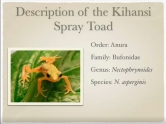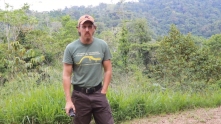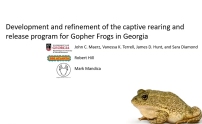Muchas poblaciones de anfibios han sido diezmadas en la naturaleza y muchas otras están severamente fragmentadas, lo que significa que colonizar un hábitat adecuado es casi imposible. La translocación es una de las herramientas en la caja de herramientas de conservación, y a menudo requiere la ayuda de programas de cría en cautiverio como fuente de animales. Esto se ha vuelto más relevante para los anfibios debido a la continua disminución de la población de muchas especies. Sin embargo, aún necesitamos comprender mejor los diferentes factores que afectan el éxito de los programas de reintroducción de anfibios.
La reintroducción junto con la mitigación de amenazas y la protección del hábitat debería ser uno de los principales objetivos de casi cualquier programa integral de conservación de anfibios. Para tener éxito, los manejadores de programas deben planificar adecuadamente los programas de reintroducción. La UICN ha producido Lineamientos Para Reintroducciones y Otras Translocaciones de Conservacións, y el Grupo de Trabajo de Reintroducción de la Alianza de Supervivencia de Anfibios ha redactado directrices específicas para anfibios.
A fines de 2019, el Arca de los Anfibios organizó un simposio de translocación en línea, que se dividió en temas, con cada uno de los temas cubiertos durante tres días a la semana, durante presentaciones de dos horas. Manejadores de programas de anfibios con mucha experiencia en reintroducciones de anfibios, evaluación de riesgo de enfermedades, manejo y restauración del hábitat, manejo de amenazas y monitoreo posterior a la liberación compartieron sus éxitos y fracasos. Otros oradores incluyeron manejadores de pequeñas poblaciones, conservacionistas de anfibios y especialistas generales en reintroducción.
Aprender de los éxitos y fracasos de los demás permite a los manejadores de programas de conservación de anfibios recopilar información nueva y no publicada y experiencias de proyectos que podrían ser útiles para diseñar mejor sus protocolos de reintroducción; evitar prácticas o estrategias fallidas; y conectarse con expertos en manejo de anfibios y otros gerentes de programas de diferentes regiones del mundo.
Las siguientes presentaciones fueron entregadas en el transcurso del simposio. Haga clic en cada imagen de video para ver la presentación. El conjunto completo de videos también está disponible como una lista de reproducción en YouTube.

Amphibian translocation best-practice IUCN guidelines: From design to application Luke Linhoff We have developed a new set of amphibian-focused translocation guidelines through a major international collaboration of reintroduction practitioners with the guidance of the IUCN’s Reintroduction Specialist Group and Amphibian Specialist Group. I will discuss the process for creating the document and the structure of the new guidelines. |

Captive breeding and reintroduction of amphibians: How far have we come since the Amphibian Conservation Action Plan? Richard A. Griffiths, Gemma Harding & Lissette Pavajeau Here we analyse the contribution to conservation made by amphibian captive breeding and reintroduction since the launch of the IUCN Amphibian Conservation Action Plan (ACAP) in 2007. The actions and targets outlined in the ACAP are designed to work towards this, but at present their implementation depends on the efforts and collaboration of a few passionate and time constrained volunteers. In order to work towards greater success, the ACAP will require more attention and resource. |

Climate change and amphibian conservation Trent Garner Amphibians are considered to be a great risk to climate change due to ectothermy, small dispersal distances and in many cases habitat requirements that encompass both aquatic and terrestrial environments. I will be discussing a few examples of how climate change may or may not be affecting amphibian abundance and species diversity, and also presenting examples of how the impacts of climate change arise through interactions with infectious diseases. |

Frog reintroductions where the amphibian chytrid fungus is the key threat David Hunter In this presentation, I will outline the progression of recovery programs for a range of frog species where the amphibian chytrid fungus is the key threat. In particular, the development of reintroduction techniques into potential environmental refugia from chytrid impacts. This includes the creation of refuge habitats that exclude reservoir host species, and also creation of breeding habitat in geographic locations that are naturally devoid of reservoir species. |

Using genetics to boost the adaptive capacity of populations: potential and challenges Ary Hoffman I start by considering the basics of reintroduction genetics and the use of terms such as genetic rescue that are often inconsistently defined in the literature. I then consider a couple of (non-amphibian) success stories to illustrate some of the issues involved in making decisions about genetic introductions and how these might be resolved. I discuss the ways in which suitable populations for reintroductions might be identified but also some of the challenges associated with developing guidelines. Finally I examine how genomic approaches can provide new tools to predict the success of reintroductions and monitor the outcome of reintroductions across time. |

IUCN SSC Guidelines on the Use of Ex-situ Management for Species Conservation Kristin Leus IUCN’s revised guidelines on the use of ex situ management for species conservation outline a decision process that identifies threats, defines potential conservation roles, and evaluates their feasibility and risks, and is applicable to all taxa and all ex situ options. Potential benefits offered by ex situ activities include addressing the causes or offsetting the impacts of specific threats, providing a source for population restoration or reinforcement, and preventing species extinction through temporary rescue or long-term insurance. Examples will be used to illustrate this. |

One Plan Approach: Integrating conservation action for species Robert Lacy The One Plan Approach calls for all initiatives on behalf of a species to be coordinated under a single conservation strategy. That strategy should encompass all populations of the species, identify the range of conservation actions that are needed, identify all resources available for the species conservation, identify the responsible parties able to implement each action. |

Alyssa Borek This talk will give an overview of the toads’ story and cover changes to the population and environment as the habitat went through many changes. |

Diane Barber The federally listed Puerto Rican Crested Toad is the only native toad of Puerto Rico and is considered Critically Endangered by the International Union for Conservation of Nature and Natural Resources. During the past four decades, this program has had many successes and failures, from which others can learn. Current challenges that will be discussed during this webinar include mitigation of rising sea levels through creation of new habitat, genetic rescue/merger of two populations for sustainability, and alteration of management strategies at reintroduction sites after a catastrophic hurricane event. |

European Green Toad conservation at Nordens Ark and habitat management and restoration on Öland Kristofer Försäter Sweden’s most at risk amphibian. Once considered a relatively common species it has during the last centuries suffered massive loss of suitable habitat with the result of local populations being isolated with no chance of gene dispersion. The presentation will be about the biology of the species in Sweden and the management of the species in captivity including breeding. Together with our partner, the County Administrative Board in Kalmar, we will look at what has been done to re-establish the species on Öland, an island in the Baltic Sea off Sweden’s southeast coast, during the last 10-15 years. |

Brian Kubicki Since 2002, the Costa Rican Amphibian Research Center has proven to be a pioneer with establishing novel and successful in situ conservation methodologies for a variety of amphibian taxa within its reserves. Through the creation of artificial and semi-natural breeding sites in the Guayacán Rainforest Reserve, the Costa Rican Amphibian Research Center has been able to greatly increase the size of an initially small reintroduced population of this species. |

Implementation of the biodiversity management plan for Pickersgill’s Reed Frog Ian Duplessis This is a small frog species endemic to KwaZulu-Natal, South Africa. Due to the small area of occurrence, which is severely fragmented, the decline of suitable habitat, increased pollution, and climate changes this specie can only be found in a few estuaries, and wetlands which are all located within 20 km of the coast. While KwaZulu-Natal is 2.303 km2, the area of occurrence of the PRF is calculated to be only 9 km2 (Measey, 2011). The IUCN currently listed the PRF as Endangered B1ab(ii.iii)+2ab(ii.iii) (IUCN, 2016). The Johannesburg Zoo were able to collect some specimens from the wild and breed them in the Zoo. A pre-release program was designed and implemented soon after and 250 specimens were successful released back into the wild. Post release monitoring have shown that the specimens adapted well and are able to continue a normal live in-situ. |

Federico Kacoliris Over the last decades, the wild populations of the Valcheta Frog, (Pleurodema somuncurense), have declined. The unique habitat where this species lives, the headwaters of the Valcheta Stream, is rapidly losing suitable conditions due to poor livestock management. As part of the conservation strategy for this species, we decided to create a rescue centre, called Cururú, and established there an ex situ assurance colony of 40 Valcheta Frogs (20 pairs). Between 2017 and 2018 a total of 250 individuals born in captivity were reintroduced in a restored habitat where a subpopulation of this frog went extinct. |

Chricahua Leopard Frog recovery in Arizona: Status and challenges Audrey Owens and Cat Crawford The Chiricahua Leopard Frog, federally listed as threatened in 2002, had declined by as much as 80% range-wide. The 2007 Recovery Plan outlines a multi-pronged recovery approach that includes habitat restoration, invasive species control, safe harbor agreements, and captive propagation, all of which have helped reestablish AZ Chiricahua Leopard Frog populations. We discuss the successes we have had with conservation of this species and the challenges that remain. |

The Mountain Chicken recovery program Matt Goetz A small number of frogs is kept under studbook management in EAZA institutions including, since 2009, a separate population held under biosecure conditions for the sole purpose of reintroductions into habitat in Montserrat. Due to the persistent Bd prevalence in the years following the 2009 Bd outbreak the then established Mountain Chicken Conservation Program involving numerous partner organisations largely conducted Bd research on Montserrat rather than actual population restoration. Here we are currently investigating whether frogs can persist with Bd in the presence of modified habitat features which might enable the frogs to limit their Bd burden to long-term survivable levels. |

Oregon Spotted Frog ex situ program Alyssa Borek Woodland Park Zoo participated with Washington Department of Fish and Wildlife and other partners in the Oregon Spotted Frog (Rana pretiosa) species recovery program from 2008–2015. This species, listed as federally Threatened in 2014, and Endangered in Washington in 1997, is declining throughout its range. This talk will give an overview of the ex situ program. |

Southern Corroboree Frog recovery program David Hunter The Southern Corroboree Frog (Pseudophryne corroboree) is a small myobatrachid frog restricted to Kosciuszko National Park that has rapidly declined in recent decades largely due to disease, caused by infection with Batrachochytrium dendrobatidis. Insurance breeding colonies have now been established at Taronga Zoo, Zoos Victoria and the Amphibian Research Centre. Experimental translocations currently include the translocation of eggs into artificial and natural pools at wild sites, eggs into artificial habitats at sites with reduced threat of the disease and frogs into large enclosures within their range that restrict vectors for the chytrid fungus. |

The Hellbender and a recovery program in western New York Penny Felski The Eastern Hellbender is a giant, aquatic salamander in the family Cryptobranchidae that reaches the most north of its’ range in New York state where it is listed as a species of Special Concern. In this presentation, I will give an overview of the Buffalo Zoo’s primary role of headstarting Hellbenders; and release techniques, survivorship, and the effects of Batrachochytrium dendrobatidis for the head-started Hellbenders. |

Development and refinement of the captive rearing and release program for Gopher Frogs in Georgia John C. Maerz, Robert Hill, Vanessa Kinney Terrell, James D. Hunt, and Sarah Diamond Gopher Frogs (Rana capito) are a state-listed threatened species in Georgia and a candidate for federal protection. We raised Gopher Frog tadpoles at different larval densities to determine the effects of larval density on size and timing at metamorphosis, and then we used radio telemetry to observed metamorph movements, microhabitat use, and fate over a two-week post-release period at two sites between 2014 and 2019. In 2006, a partnership was started between several institutions and organizations to head start specimens for repatriation purposes. |

Jessie Bushell The San Francisco Zoo and Gardens has been working with a variety of partners to reintroduce and translocate two of California’s most iconic amphibians – the Sierra Nevada Yellow-legged Frog and the California Red-legged Frog. Both species have undergone significant and severe population reductions leading to federal listings of endangered and threatened respectively. So far the San Francisco Zoo has successfully reintroduced over 1,000 California Red-legged Frogs to Yosemite National Park and hundreds of Yellow-legged Frogs to several national forests and parks, though each population and release has its own challenges and success stories. |

Striped Newt conservation at the Jacksonville Zoo and Gardens Mark Beshel Striped Newt (Notophthalmus perstriatus), once common throughout the southeastern United States have become increasingly rare. These salamanders are considered “near-threatened”, though several populations are considered to be extirpated. In 2012, the Jacksonville Zoo partnered with the Memphis Zoo to start an ambitious reintroduction program within their historic range within the Apalachicola National Forest. |

Conservation breeding, research and reintroduction of southern Mountain Yellow-legged Frogs Debra M. Shier, Ph.D. The Mountain Yellow-legged Frog (Rana muscosa) is a California state, federal, and IUCN-listed endangered species facing many of the factors that threaten amphibians globally: invasive predators, habitat loss, climate change, and disease. The San Diego Zoo Institute for Conservation Research established a conservation breeding program for Mountain Yellow-legged Frog in 2006. We use research on the species behavioral ecology, physiology and genetics in an adaptive management framework to optimize our breeding and release outcomes. We work collaboratively with state, federal, and other partners to produce ~1000 individuals annually, and have reintroduced frogs into the wild since 2010. |

Yellow-spotted Bell Frog conservation program Michael McFadden The Yellow-spotted Bell Frog (Litoria castanea) is one of Australia’s most endangered amphibian species, that was thought to have gone extinct by 1980 following the arrival of amphibian chytrid fungus. Fortunately, in 2009, the species was rediscovered on a small stretch of rural creek line in the Southern Tablelands of New South Wales. An insurance colony of the species has been established at Taronga Zoo, Sydney. In November 2017, after trialling a number of different techniques, breeding was achieved and offspring were produced to provide extra insurance for the species and trial translocation at two sites. This was followed by successful breeding the following season. Initial translocations are now underway, with close to two thousand frogs released in an effort to establish the species in the wild and formulate translocation protocols to guide further reintroductions efforts for this species. |

Introduction to post-release monitoring techniques Luke Linhoff Post-release monitor is an important component of any translocation since it helps measuring the success of the program. This presentation discuss different amphibian post-release monitoring techniques. |

Blake Klocke Captive assurance populations of five Atelopus spp. (Atelopus certus, Atelopus glyphus, Atelopus limosus, Atelopus varius, and Atelopus zeteki) have been successfully maintained and bred in Panama. Release trials with captive bred F1 individuals of two species, Atelopus limosus and Atelopus varius, were completed to understand dispersal patterns, survivorship, susceptibility to chytrid, and increase efficacy of future reintroductions. These initial efforts will guide the development of reintroduction strategies in the presence of the pathogen driving the declines of Panamanian amphibians. |

Recovering the White-bellied Frog in south-west Western Australia Kay Bradfield, Cathy Lambert, Kim Williams Critically Endangered White-bellied Frogs (Geocrinia alba) are endemic to a small area of south-west Western Australia. Recovery efforts are guided by a Recovery Team, and include a head-starting program at Perth Zoo. Zoo staff collect eggs / larvae from the wild each spring and rear them for 10-11 months before releasing them back to the wild as juveniles the following spring. Over the last 10 years, approximately 900 head-started froglets have been released into six sites to establish new populations and augment existing ones. |

Do’s and dont’s of amphibian translocation round table Christman, S. Wren, A. Adams, J. Mendelson Worldwide recognized amphibian biologists discuss amphibian translocation and comment about the different programs presented during the AArk Amphibian Translocation Symposium. |







